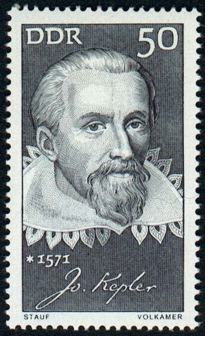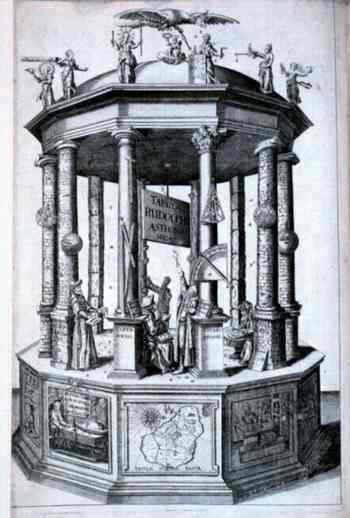Johannes Kepler
Astronomer, b. 27 December 1571 (Weil der Stadt, Germany), d. 15 November 1630 (Regensburg).
 Kepler was the son of a mercenary soldier; his mother was the daughter of an innkeeper. He was born prematurely and throughout his life was of variable health. As a young child he showed remarkable intelligence and was chosen for one of the scholarships available from the dukes of Württemberg for gifted children of the poor.
Kepler was the son of a mercenary soldier; his mother was the daughter of an innkeeper. He was born prematurely and throughout his life was of variable health. As a young child he showed remarkable intelligence and was chosen for one of the scholarships available from the dukes of Württemberg for gifted children of the poor.
Kepler entered the University of Tübingen in 1587 to study astronomy under Professor Michael Mästlin, one of the few astronomers who believed that Copernicus was correct in saying that the Earth rotates around the Sun. Having obtained his B.A. in 1588 and his M.A. in 1591 he continued at the university in theological studies, with the aim to become a Lutheran minister. He did not finish this training but was appointed teacher of mathematics at the Lutheran high school of Graz, Austria, where the previous teacher had just died, in 1594.
While teaching at the high school Kepler wrote his first major work, the "Cosmographic Mystery", in which he tried to describe the movement of the Copernican planets in terms of celestial harmony, represented by movement on circles. He sent copies of his work to famous scientists including Tycho Brahe, the astronomer and imperial mathematician of the Holy Roman Empire. Brahe was impressed and in 1600 invited Kepler to join the scientific team at the imperial observatory at Benatek (today's Benátky nad Jazerou) near Prague. Brahe died the next year, and Kepler was appointed his successor.
Access to the best astronomical observations available in Europe at the time allowed Kepler to develop his ideas about planetary movement further. In 1609 he had given up on the idea of perfect circular motion and demonstrated that the orbit of Mars is an ellipse. This finding, together with two other major deductions from observations, became known as Kepler's Laws:
- All planets move on elliptical orbits, with the Sun in one of the foci.
- The line between the Sun and a planet traverses equal areas in equal times.
- The ratio of the cube of the distance between the Sun and a planet to the square of the time required for one completion of its orbit is a constant for all planets.
A change of emperor caused Kepler to move from Prague to Linz, Austria, but he remained imperial mathematician and continued his studies. His Epitome Astronomiae Copernicanae (Epitome of Copernican Astronomy) was published in 1618 - 1621. A peasant revolt against forced conversion to catholicism, combined with higher taxes, prevented Kepler from having his Tabulae Rudolphinae, a catalogue of 1,005 stars, printed there. They were eventually published in Ulm, Germany, in 1627.
In 1628 Kepler moved to Zagan, Silesia, to establish his own printing press under the sponsorship of the duke of Friedland and Zagan, Albrecht von Wallenstein. In 1630 he travelled to Austria but fell ill on the way and died in Regensburg, Germany.
Portrait: postage stamp of the German Democratic Republic; public domain (Wikipedia)
Frontispiece of the Tabulae Rudolphinae

Archival Photograph by S. Nicklas, Central Library National Oceanic & Atmospheric Adminstration (NOAA), USA; public domain (US government)
home
 Kepler was the son of a mercenary soldier; his mother was the daughter of an innkeeper. He was born prematurely and throughout his life was of variable health. As a young child he showed remarkable intelligence and was chosen for one of the scholarships available from the dukes of Württemberg for gifted children of the poor.
Kepler was the son of a mercenary soldier; his mother was the daughter of an innkeeper. He was born prematurely and throughout his life was of variable health. As a young child he showed remarkable intelligence and was chosen for one of the scholarships available from the dukes of Württemberg for gifted children of the poor.